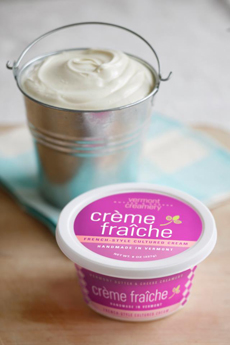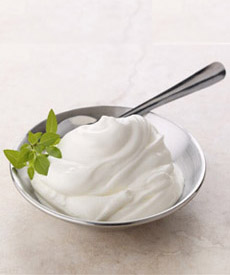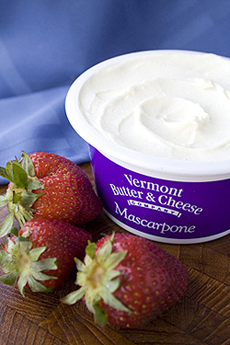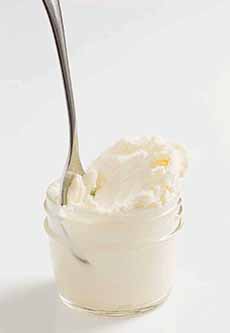|

[1] In photos, four cream-based products can look alike. But the flavor, weight and production techniques differ. Vive la différence: they’re all wonderful. This is crème fraîch (photo © Vermont Creamery).

[2] Sour cream is thicker and tart notes (photo © Wisconsin Milk Marketing Board).
|
|
Cream is easily whipped into a delicious topping or filling. With a bit more effort at the dairy, it can be turned into enriched creams, including clotted cream, crème fraîche, mascarpone, and sour cream. Each has its own distinct character, and each is a gift to people who love a bit of richness.
IT STARTS WITH MILK
Cream starts with milk, a suspension of whey proteins, casein proteins, and globules of fat in water.
The largest amount of the suspension is fat (milkfat a.k.a. butterfat), which is also the lightest component.
If the milk is not homogenized, it rises to the top to a rich cream layer. The longer the milk sits at warm temperatures (which speed separation), the richer and thicker the cream becomes.*
Cream can also be thickened by fermenting with Lactobacillus bacteria, which is how three of our four featured, enhanced creams are made.
In the U.S., the raw milk is heated (pasteurized) and the fat (cream) is separated (leaving nonfat milk). It can then be processed into different products:
Clotted cream/Devon cream, which relies on boiling and resting time to thicken (double cream is similar to clotted cream but with a higher fat content).
Crème fraîche, cream cultured/thickened with Lactobacillus bacteria, a lighter, thinner alternative to sour cream†.
Mascarpone, the Italian version of crème fraîche, but thicker and sweeter, soured by a lactic culture or an acid like vinegar or cream of tartar.
Sour cream, cream that gets its sharp, tart edge by adding Lactobacillus culture.
The cultured creams all have a delightful, piquant edge. We like them even better than the simple, often-too-sweet whipped cream, to garnish chocolate cakes and other sweet, rich desserts.
____________________
*Historically, dairy farmers skimmed the cream from shallow pans of milk, let it sit again, and did this repeatedly to get the richest cream. Modern dairies use massive centrifuges to perform the same task in seconds (and produce creams with a consistent percentage of milk fat).
†Note that depending on the producer, crème fraîche can be thicker than sour cream, or vice versa.
|
MILK FAT COMPARISONS
These comparisons help to explain the difference among products created from milk. Note that the percentages are averages; different dairies can manage their recipes to include more or less fat. (Note that milk fat/milkfat is the same as butter fat/butterfat.)
Nonfat milk: 0%-1% fat
1% and 2% milk: 1%-2% fat
Lowfat milk: 2%-4% fat
Whole milk: 4% fat
Half-and-half: 12%-15% fat (it’s half milk, half cream)
Sour cream: 18%-20% fat
Light cream: 18%-30% fat
Heavy cream (whipping cream): 30%-36% fat
Crème fraîche: 35%-40% fat
Heavy whipping cream: 36%-44% fat
Manufacturer’s cream: 44% fat or higher (not available in consumer markets)
Double cream: 43%-48% fat or higher
Clotted cream/Devon cream: 60% fat
Mascarpone: 70%-75% fat
Butter: 80%–84% fat
CLOTTED CREAM or DEVON CREAM
Heavy whipping cream is warmed gently to a near boil, so the fat globules float to the top and form a firm layer. It is then left to cool for a day (photo #4).
This is the famed clotted cream of Devon and Somerset, England: a very rich, thick delight of about 60% milk fat, with flavors both creamy and buttery.
Clotted cream is popularly enjoyed with fruit preserves on scones, on other baked goods, or as a topping for fresh fruit.
CRÈME FRAÎCHE
Developed in France, crème fraîche (pronounced crehm fresh) is a thinner form of sour cream, with a more delicate texture and tartness, and a higher fat content (photo #1).
Cream is gently heated and then inoculated with bacterial cultures. The bacteria consume the cream’s natural sugars, producing lactic acid in exchange.
This gentle acidity thickens the cream and imparts a mild, refreshing tang (less tang than sour cream because the amounts of the bacterial cultures used are far fewer).
Crème fraîche is used as a topping, in sauces and other recipes. Aside from the celestial taste, the best thing about crème fraîche is that it can be heated and used in sauces without curdling.
And, you can make it at home. Here’s a crème fraîche recipe; a quicker alternative is to blend equal amounts of heavy whipping cream and sour cream.
|
|
MASCARPONE
Mascarpone takes a third approach to thickening cream (photo #3).
The result is the richest, sweetest and most luscious; and spoonable, spreadable mascarpone is actually classified as a fresh cheese (a triple-crème).
The cream is brought to a simmer until approximately a third of its original volume has evaporated.
Then, an acid ingredient such as vinegar or cream of tartar is mixed into the warm, extra-rich cream.
The acidity causes the cream to congeal to a thick, almost stiff texture while retaining its mild and creamy flavor.
It is the thickest and richest enriched cream, at 70%-75% milk fat.
Mascarpone is intensely rich and used for desserts (cannoli filling, tiramisu, cheesecake, with fresh fruit) as well as in savory recipes (dips, sauces, spreads).
It is often called “Italian cream cheese,” but the two products are technically different—and different on the palate, too.
SOUR CREAM
Sour cream is made by fermenting heavy cream with certain kinds of lactic acid bacteria; the production of lactic acid by bacterial fermentation is called souring.
The bacterial culture sours and thickens the cream (photo #2).
The taste of sour cream is only mildly sour; tangy would be a better word.
Sour cream is used in recipes, as a base for dips, and as a garnish and topping.
Note that reduced fat and fat-free options are made with numerous additives: propylene glycol monoester, an emulsifier that helps aerate the cream. Corn starch, gelatin, agar gum, locust bean, and xantham gum replace the viscosity lost with the the fat; artificial color keeps the mix a milky white [source].
YOGURT
Yogurt is milk—not cream—that is fermented with bacteria.
The milk is heated and mixed with two types of live bacteria: Lactobacillus bulgaricus and Streptococcus thermophilus. Some brands add additional live bacteria, or copyright their own versions of the two main types.
These are good bacteria: probiotic bacteria that keep our guts healthy.
|
|

[3] Mmm, mmm, mascarpone! Mascarpone is thicker and has sweet notes, although there is no added sugar (photo © The Nibble | Claire Freiermann).

[4] Clotted cream, also called Devon cream. Here’s how to make it yourself, from heavy cream (photo © Cupcake Project).
|
The bacteria convert lactose (milk sugar) to lactic acid. This sets the mixture sets and develops its characteristic tang.
Greek-style yogurt triple-strains the mixture to remove a great percentage of whey, resulting in a thicker yogurt.
Skyr, also called Icelandic yogurt, strains out all the whey. The result is even thicker, creamier, and higher in protein. Here are the different types of yogurt.
Yogurt can be used as sour cream is used, to cut back on cholesterol (fat) and calories.
However, it can’t be heated like sour cream: It will curdle in the heat.
Some material in this article was adapted from GlobalPost.com.
CHECK OUT WHAT’S HAPPENING ON OUR HOME PAGE, THENIBBLE.COM.
|
|